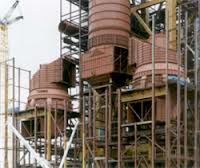Regenerative Heat Exchangers
Regenerative heat exchangers consist of a storage mass (heating elements) which continuously absorbs and releases heat between two or more flowing media.
Features
Regenerative heat exchangers feature rigid design, high reliability and excellent performance, which ensures an uninterrupted, economical operation.
Working Principles
Whereas in recuperators, where heat is transferred directly and immediately through a partition wall of some kind, from a hot to a cold fluid, both of which flow simultaneously through the exchanger, the operation of the regenerative heat exchanger involves the temporary storage of the heat transferred in a packing which possesses the necessary thermal capacity. One consequence of this is that in regenerative heat exchangers or thermal regenerators, the hot and cold fluids pass through the same channels in the packing, alternately, both fluids washing the same surface area. In recuperators, the hot and cold fluids pass simultaneously through different but adjacent channels. In thermal regenerator operation the hot fluid passes through the channels of the packing for a length of time called the "hot period," at the end of which, the hot fluid is switched off. A reversal now takes place when the cold fluid is admitted into the channels of the packing, initially driving out any hot fluid still resident in these channels, thereby purging the regenerator. The cold fluid then flows through the regenerator for a length of time called the "cold period," at the end of which the cold fluid is switched off and another reversal occurs in which, this time, the hot fluid purges the channels of the packing of any remaining cold fluid. A fresh hot period then begins. During the hot period, heat is transferred from the hot fluid and is stored in the packing of the regenerator. In the subsequent cold period, this heat is regenerated and is transferred to the cold fluid passing through the exchanger. A cycle of operation consists of a hot followed by a cold period of operation together with the necessary reversals. After many cycles of identical operation, the temperature performance of the thermal regenerator in one cycle is identical to that in the next. When this condition is realized, the heat exchanger is said to have reached "cyclic equilibrium" or "periodic steady state." Should a step change be introduced in one or more of the operating parameters, in particular, the flow rate and entrance temperature of the fluid for either period of operation, or the duration of the hot and cold periods, the regenerator undergoes a number of transient cycles until the new cyclic equilibrium is reached. In the most common counterflow or contraflow regenerator operation, the hot gas passes through the regenerator in the opposite direction of the cold fluid. In less efficient parallel flow or co-flow the hot and cold fluids pass through the channels of the packing in the same direction(†). (†) In theory, it is possible to imagine a cross-flow regenerator in which the hot and cold fluids flow in directions perpendicular to one another. This is rarely, if ever, realized in practice although cross-flow recuperators are common. The periodic operation of regenerators can exploit the periodic operation of the system to which the exchanger is attached. For example, in hot climates, day time heat can be stored in a packing by passing the warm atmospheric air through it: this heat can then be recovered by blowing cold night time air through the same packing during the evening to provide at least some supplementary warming of the living space in a building. Hausen (1976) suggests that the throat and nasal passages act as a regenerator packing in cold weather. When an animal breathes in cold air, it is warmed as it passes through the nose and throat before the air reaches the lungs, thereby protecting the lungs from the effects of cold temperatures. As the animal breathes out, the same passages in the nose and throat are warmed by the air leaving the lungs. Clearly, the temperature of the throat and nasal tissue is also regulated by the flow of blood through it. In general, however, a continuous supply of heated fluid is required so that the discontinuous operation of the regenerator, which is inherent in its design, must be concealed in some way.
Video
